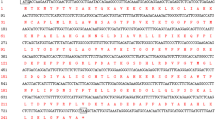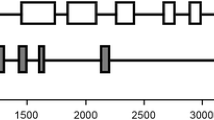Abstract
A cDNA clone encoding ascorbate peroxidase (AP, EC 1.11.1.11) was isolated from a phage λgt11 library of cDNA fromArabidopsis thaliana by immunoscreening with monoclonal antibodies against the enzyme, and then sequenced. The cDNA insert hybridized to a 1.1 kb poly(A)+ RNA from leaves ofA thaliana. Genomic hybridization suggests that the cDNA obtained here corresponds to a single-copy gene. The N-terminal amino acid sequence ofArabidopsis AP was determined by protein sequencing of the immunochemically purified enzyme, and proved to be homologous to the N-terminal amino acid sequence of the chloroplastic AP of spinach. The predicted amino acid sequence of the mature AP ofA. thaliana, deduced from the nucleotide sequence, consists of 249 amino acid residues, which is 34% homologous with cytochromec peroxidase of yeast, but less homologous with other plant peroxidases. Amino acid residues at the active site of yeast cytochromec peroxidase are conserved in the amino acid sequence ofArabidopsis AP. The poly(dG-dT) sequence, which is a potential Z-DNA-forming sequence, was found in the 3′ untranslated region of the cDNA.
Similar content being viewed by others
References
An G: A potential Z-DNA-forming sequence is an essential upstream element of a plant promoter. BioEssays 7: 211–214 (1987).
Ausubel FM, Brent R, Kingston RE, Moore DD, Seidman JG, Smith JA, Struhl K: Current Protocols in Molecular Biology. John Wiley & Sons, New York (1987).
Boveris A, Sies H, Martino EE, Docampo R, Turrens JF, Stoppani AOM: Deficient metabolic utilization of hydrogen peroxide inTrypanosoma cruzi. Biochem J 188: 643–648 (1980).
Chen G-X, Asada K: Ascorbate peroxidase in tea leaves: Occurrence of two isozymes and the differences in their enzymatic and molecular properties. Plant Cell Physiol 30: 987–998 (1989).
Church GM, Gilbert W: Genomic sequencing. Proc Natl Acad Sci USA 81: 1991–1995 (1984).
Dasgupta S, Rousseau DL, Anni H, Yonetani T: Structural characterization of cytochromec peroxidase by resonance Raman scattering. J Biol Chem 264: 654–662 (1989).
Fujiyama K, Takemura H, Shinmyo A, Okuda H, Takano M: Genomic DNA structure of two new horseradish-peroxidase-encoding genes. Gene 89: 163–169 (1990).
Gerbling K-P, Kelly GJ, Fischer K-H, Latzko E: Partial purification and properties of soluble ascorbate peroxidase from pea leaves. J Plant Physiol 115: 59–67 (1984).
Gillham DJ, Dodge AD: Hydrogen-peroxide-scavenging systems within pea chloroplasts. Planta 167: 246–251 (1986).
Heidecker G, Messing J: Structural analysis of plant genes. Annu Rev Plant Physiol 37: 436–466 (1986).
Hossain MA, Asada K: Inactivation of ascorbate peroxidase in spinach chloroplasts on dark addition of hydrogen peroxide: Its protection by ascorbate. Plant Cell Physiol 25: 1285–1295 (1984).
Hossain MA, Nakano Y, Asada K: Monodehydroascorbate reductase in spinach chloroplasts and its participation in regeneration of ascorbate for scavenging hydrogen peroxide. Plant Cell Physiol 25: 385–395 (1984).
Huynh TV, Young RA, Davis RW: Constructing and screening cDNA libraries in λgt10 and λgt11. In: Glover DM (ed), DNA Cloning: A Practical Approach, Vol. I, pp. 49–78. IRL, Oxford (1985).
Ishihara H, Shikita M: Electroblotting of double-stranded DNA for hybridization experiments: DNA transfer is complete within 10 minutes after pulse-field gel electrophoresis. Anal Biochem 184: 207–212 (1990).
Kaput J, Goltz S, Blobel G: Nucleotide sequence of the yeast nuclear gene for cytochromec peroxidase precursor: Functional implications of the pre sequence for protein transport into mitochondria. J Biol Chem 257: 15054–15058 (1982).
Kelly GJ, Latzko E: Soluble ascorbate peroxidase. Naturwissenschaften 66: 617–618 (1979).
Kornfeld R, Kornfeld S: Assembly of asparagine-linked oligosaccharides. Annu Rev Biochem 54: 631–664 (1985).
Lagrimini LM, Burkhart W, Moyer M, Rothstein S: Molecular cloning of complementary DNA encoding the lignin-forming peroxidase from tobacco: Molecular analysis and tissue-specific expression. Proc Natl Acad Sci USA 84: 7542–7546 (1987).
Marchalonis JJ, Weltman JK: Relatedness among proteins: A new method of estimation and its application to immunoglobulins. Comp Biochem Physiol 38B: 609–625 (1971).
Matsudaira P: Sequence from picomole quantities of proteins electroblotted onto polyvinylidene difluoride membranes. J Biol Chem 262: 10035–10038 (1987).
Mazza G, Welinder KG: Covalent structure of turnip peroxidase 7: Cyanogen bromide fragments, complete structure, and comparison to horseradish peroxidase C. Eur J Biochem 108: 481–489 (1980).
Mehlhorn H, Cottam DA, Lucas PW, Wellburn AR: Induction of ascorbate peroxidase and glutathione reductase activities by interaction of mixtures of air pollutants. Free Rad Res Comm 3: 193–197 (1987).
Miyake C, Michihata H, Asada K: Scavenging of hydrogen peroxide in prokaryotic and eukaryotic algae: Acquisition of ascorbate peroxidase during the evolution of cyanobacteria. Plant Cell Physiol 32: 33–43 (1991).
Nakano Y, Asada K: Hydrogen peroxide is scavenged by ascorbate-specific peroxidase in spinach chloroplasts. Plant Cell Physiol 22: 867–880 (1981).
Nakano Y, Asada K: Purification of ascorbate peroxidase in chloroplasts; its inactivation in ascorbate-depleted medium and reactivation by monodehydroascorbate radical. Plant Cell Physiol 28: 131–140 (1987).
Nakano Y, Edwards GE: Hill reaction, hydrogen peroxide scavenging, and ascorbate peroxidase activity of mesophyll and bundle sheath chloroplasts of NADP-malic enzyme type C4 species. Plant Physiol 85: 294–298 (1987).
Poulos TL, Freer ST, Alden RA, Edwards SL, Skogland U, Takio K, Eriksson B, Xuong N, Yonetani T, Kraut J: The crystal structure of cytochromec peroxidase. J Biol Chem 255: 575–580 (1980).
Poulos TL, Kraut J: A hypothetical model of the cytochromec peroxidase. cytochromec electron transfer complex. J Biol Chem 255: 10322–10330 (1980).
Rich A, Nordheim A, Wang AH-J: The chemistry and biology of left-handed Z-DNA. Annu Rev Biochem 53: 791–846 (1984).
Rönnberg M, Kalkkinen N, Ellfolk N: The primary structure ofPseudomonas cytochromec peroxidase. FEBS Lett 250: 175–178 (1989).
Saji H, Tanaka K, Kondo N: Monoclonal antibodies to spinach ascorbate peroxidase and immunochemical detection of the enzyme in eight different plant species. Plant Sci 69: 1–9 (1990).
Sambrook J, Fritsch EF, Maniatis T: Molecular Cloning: A Laboratory Manual, 2nd ed. Cold Spring Harbor Laboratory, Cold Spring Harbor, NY (1989).
Shigeoka S, Nakano Y, Kitaoka S: Purification and some properties of L-ascorbic acid-specific peroxidase inEuglena gracilis Z. Arch Biochem Biophys 201: 121–127 (1980).
Smirnoff N, Colombé SV: Drought influences the activity of enzymes of the chloroplast hydrogen peroxide scavenging system. J Exp Bot 39: 1097–1108 (1988).
Takio K, Titani K, Ericsson LH, Yonetani T: Primary structure of yeast cytochromec peroxidase II. The complete amino acid sequence. Arch Biochem Biophys 203: 615–629 (1980).
Tanaka K, Masuda R, Sugimoto T, Omasa K, Sakaki T: Water deficiency-induced changes in the contents of defensive substances against active oxygen in spinach leaves. Agric Biol Chem 54: 2629–2634 (1990).
Tanaka K, Suda Y, Kondo N, Sugahara K: O3 tolerance and the ascorbate-dependent H2O2 decomposing system in chloroplasts. Plant Cell Physiol 26: 1425–1431 (1985).
Tanaka K, Takeuchi E, Kubo A, Sakaki T, Haraguchi K, Kawamura Y: Two immunologically different isozymes of ascorbate peroxidase from spinach leaves. Arch Biochem Biophys 286: 371–375 (1991).
Tel-Or E, Huflejt ME, Packer L: Hydroperoxide metabolism in cyanobacteria. Arch Biochem Biophys 246: 396–402 (1986).
Triggs-Raine BL, Doble BW, Mulvey MR, Sorby PA, Loewen PC: Nucleotide sequence ofkatG, encoding catalase HPI ofEscherichia coli. J Bact 170: 4415–4419 (1988).
Welinder KG: Amino acid sequence studies of horseradish peroxidase: Amino and carboxyl termini, cyanogen bromide and tryptic fragments, the complete sequence, and some structural characteristics of horseradish peroxidase C. Eur J Biochem 96: 483–502 (1979).
Author information
Authors and Affiliations
Rights and permissions
About this article
Cite this article
Kubo, A., Saji, H., Tanaka, K. et al. Cloning and sequencing of a cDNA encoding ascorbate peroxidase fromArabidopsis thaliana . Plant Mol Biol 18, 691–701 (1992). https://doi.org/10.1007/BF00020011
Received:
Accepted:
Issue Date:
DOI: https://doi.org/10.1007/BF00020011




